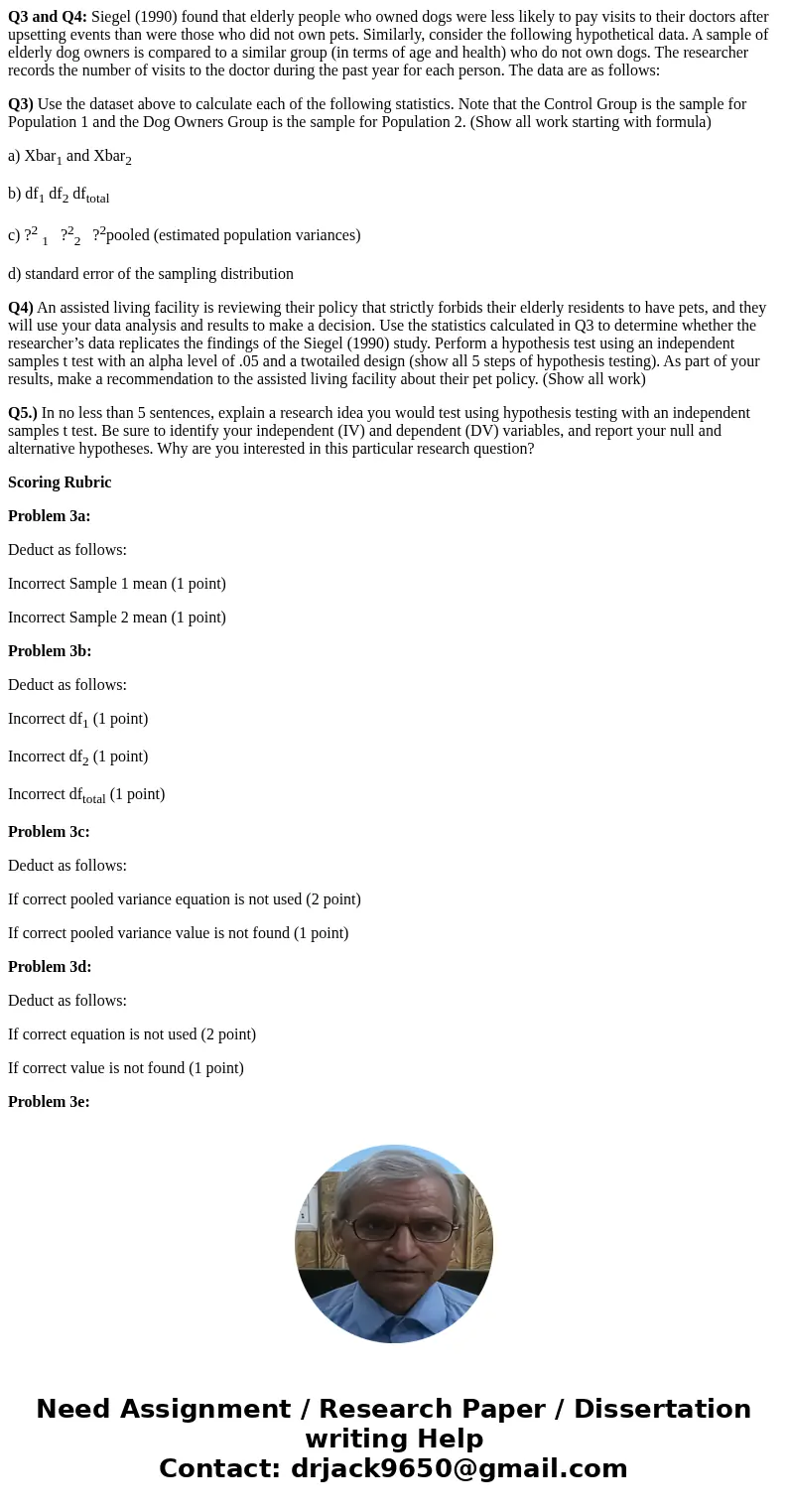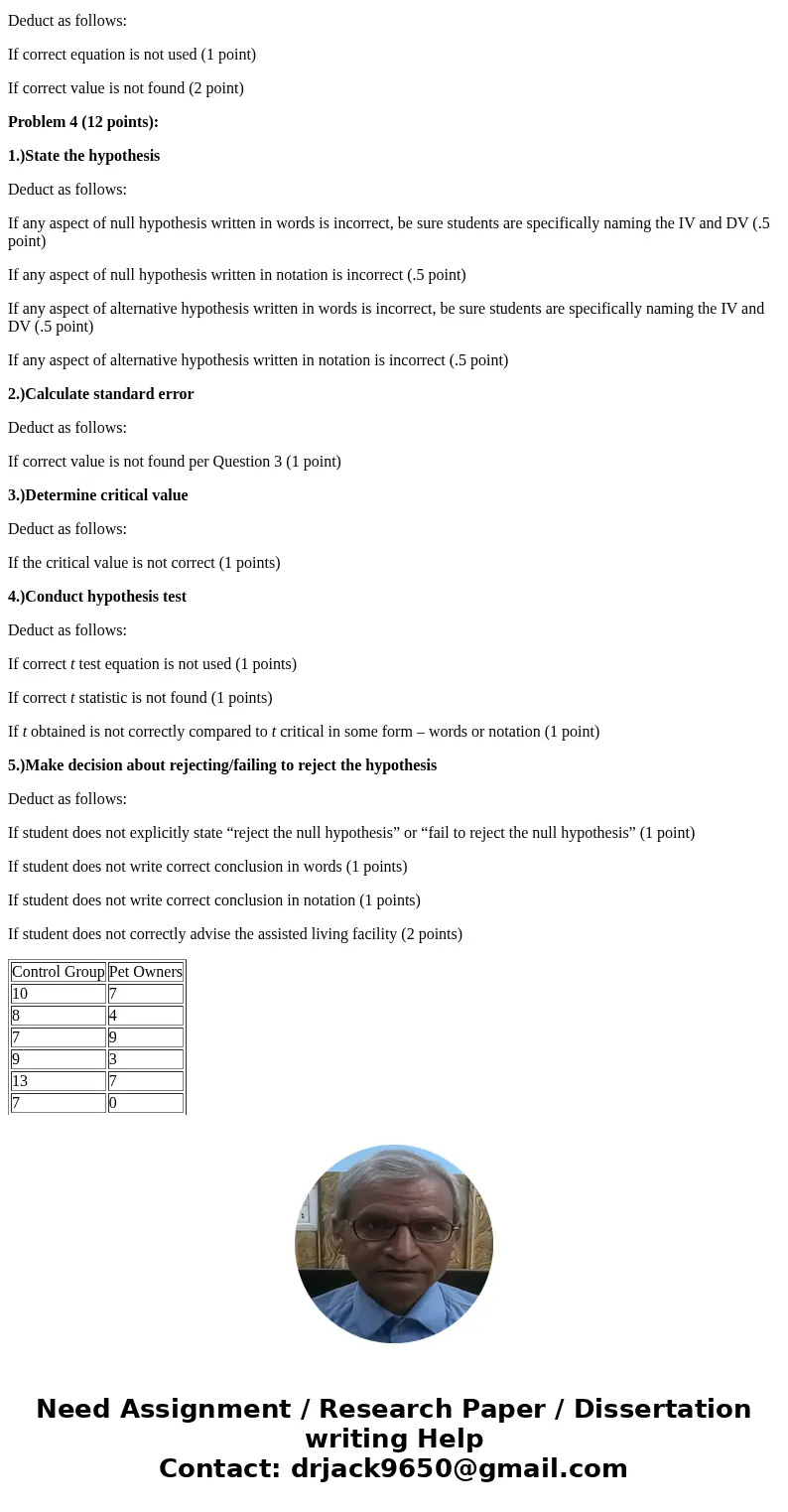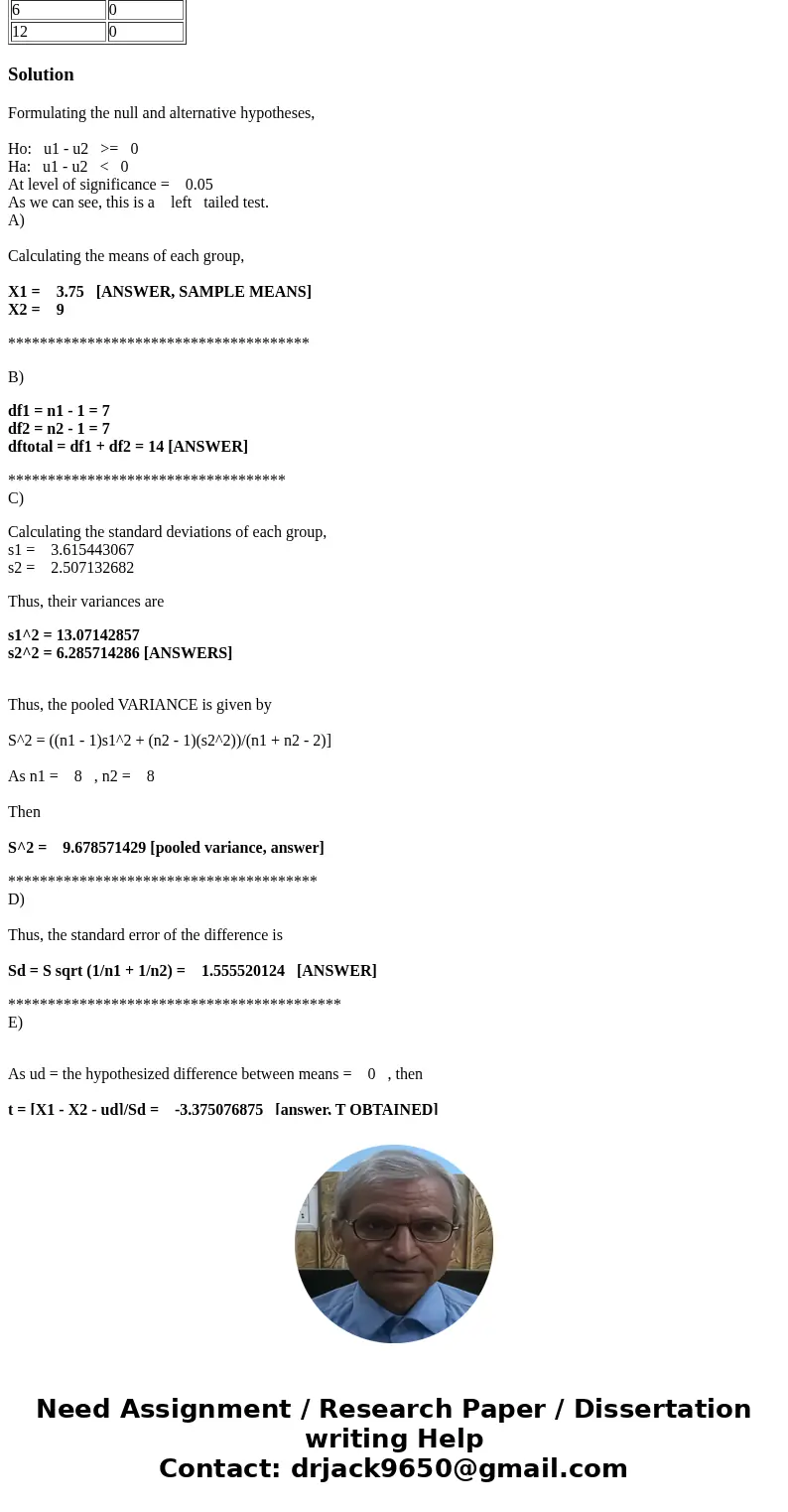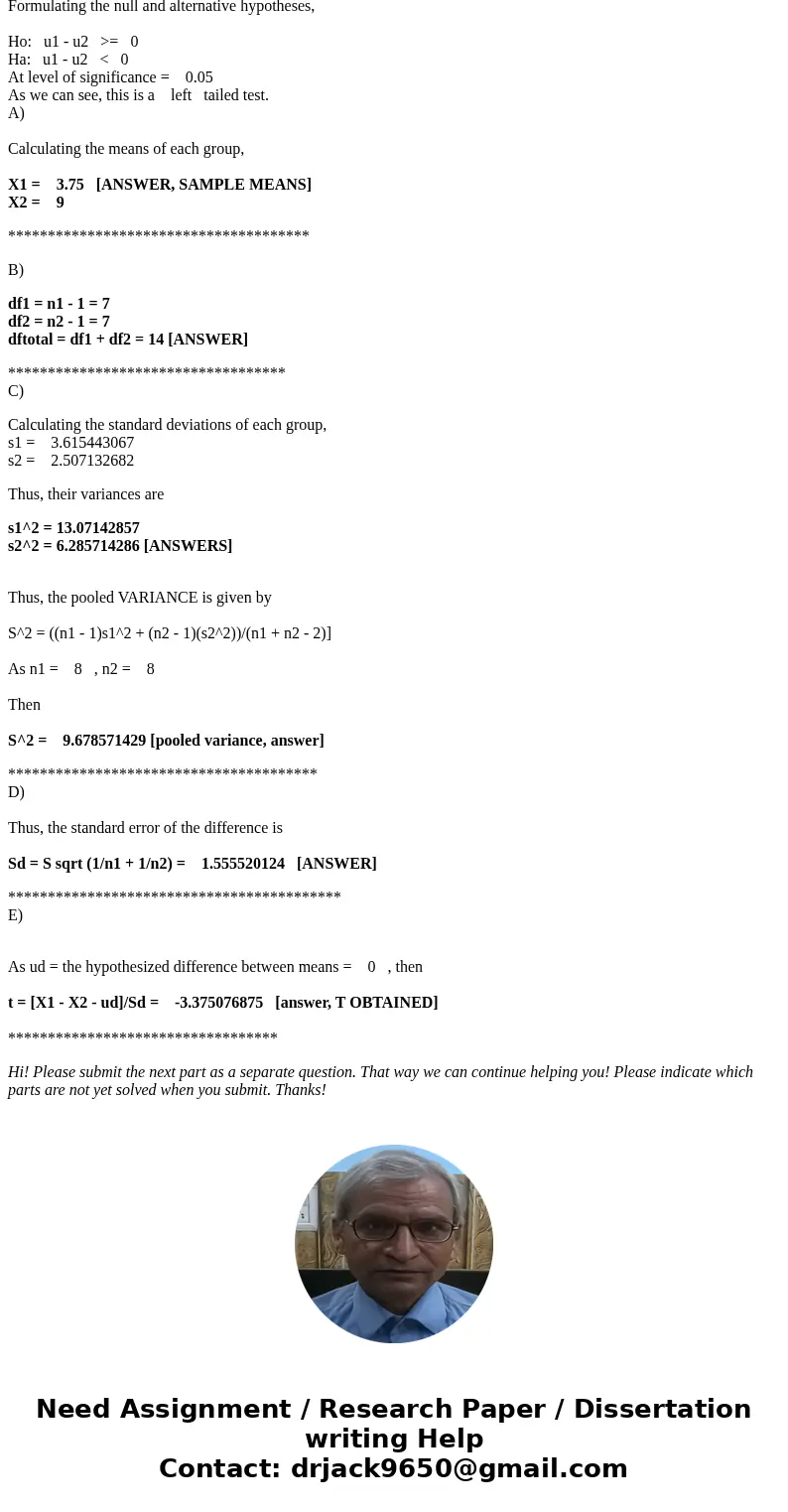Q3 and Q4 Siegel 1990 found that elderly people who owned do
Q3 and Q4: Siegel (1990) found that elderly people who owned dogs were less likely to pay visits to their doctors after upsetting events than were those who did not own pets. Similarly, consider the following hypothetical data. A sample of elderly dog owners is compared to a similar group (in terms of age and health) who do not own dogs. The researcher records the number of visits to the doctor during the past year for each person. The data are as follows:
Q3) Use the dataset above to calculate each of the following statistics. Note that the Control Group is the sample for Population 1 and the Dog Owners Group is the sample for Population 2. (Show all work starting with formula)
a) Xbar1 and Xbar2
b) df1 df2 dftotal
c) ?2 1 ?22 ?2pooled (estimated population variances)
d) standard error of the sampling distribution
Q4) An assisted living facility is reviewing their policy that strictly forbids their elderly residents to have pets, and they will use your data analysis and results to make a decision. Use the statistics calculated in Q3 to determine whether the researcher’s data replicates the findings of the Siegel (1990) study. Perform a hypothesis test using an independent samples t test with an alpha level of .05 and a twotailed design (show all 5 steps of hypothesis testing). As part of your results, make a recommendation to the assisted living facility about their pet policy. (Show all work)
Q5.) In no less than 5 sentences, explain a research idea you would test using hypothesis testing with an independent samples t test. Be sure to identify your independent (IV) and dependent (DV) variables, and report your null and alternative hypotheses. Why are you interested in this particular research question?
Scoring Rubric
Problem 3a:
Deduct as follows:
Incorrect Sample 1 mean (1 point)
Incorrect Sample 2 mean (1 point)
Problem 3b:
Deduct as follows:
Incorrect df1 (1 point)
Incorrect df2 (1 point)
Incorrect dftotal (1 point)
Problem 3c:
Deduct as follows:
If correct pooled variance equation is not used (2 point)
If correct pooled variance value is not found (1 point)
Problem 3d:
Deduct as follows:
If correct equation is not used (2 point)
If correct value is not found (1 point)
Problem 3e:
Deduct as follows:
If correct equation is not used (1 point)
If correct value is not found (2 point)
Problem 4 (12 points):
1.)State the hypothesis
Deduct as follows:
If any aspect of null hypothesis written in words is incorrect, be sure students are specifically naming the IV and DV (.5 point)
If any aspect of null hypothesis written in notation is incorrect (.5 point)
If any aspect of alternative hypothesis written in words is incorrect, be sure students are specifically naming the IV and DV (.5 point)
If any aspect of alternative hypothesis written in notation is incorrect (.5 point)
2.)Calculate standard error
Deduct as follows:
If correct value is not found per Question 3 (1 point)
3.)Determine critical value
Deduct as follows:
If the critical value is not correct (1 points)
4.)Conduct hypothesis test
Deduct as follows:
If correct t test equation is not used (1 points)
If correct t statistic is not found (1 points)
If t obtained is not correctly compared to t critical in some form – words or notation (1 point)
5.)Make decision about rejecting/failing to reject the hypothesis
Deduct as follows:
If student does not explicitly state “reject the null hypothesis” or “fail to reject the null hypothesis” (1 point)
If student does not write correct conclusion in words (1 points)
If student does not write correct conclusion in notation (1 points)
If student does not correctly advise the assisted living facility (2 points)
| Control Group | Pet Owners |
| 10 | 7 |
| 8 | 4 |
| 7 | 9 |
| 9 | 3 |
| 13 | 7 |
| 7 | 0 |
| 6 | 0 |
| 12 | 0 |
Solution
Formulating the null and alternative hypotheses,
Ho: u1 - u2 >= 0
Ha: u1 - u2 < 0
At level of significance = 0.05
As we can see, this is a left tailed test.
A)
Calculating the means of each group,
X1 = 3.75 [ANSWER, SAMPLE MEANS]
X2 = 9
**************************************
B)
df1 = n1 - 1 = 7
df2 = n2 - 1 = 7
dftotal = df1 + df2 = 14 [ANSWER]
***********************************
C)
Calculating the standard deviations of each group,
s1 = 3.615443067
s2 = 2.507132682
Thus, their variances are
s1^2 = 13.07142857
s2^2 = 6.285714286 [ANSWERS]
Thus, the pooled VARIANCE is given by
S^2 = ((n1 - 1)s1^2 + (n2 - 1)(s2^2))/(n1 + n2 - 2)]
As n1 = 8 , n2 = 8
Then
S^2 = 9.678571429 [pooled variance, answer]
***************************************
D)
Thus, the standard error of the difference is
Sd = S sqrt (1/n1 + 1/n2) = 1.555520124 [ANSWER]
******************************************
E)
As ud = the hypothesized difference between means = 0 , then
t = [X1 - X2 - ud]/Sd = -3.375076875 [answer, T OBTAINED]
**********************************
Hi! Please submit the next part as a separate question. That way we can continue helping you! Please indicate which parts are not yet solved when you submit. Thanks!




 Homework Sourse
Homework Sourse